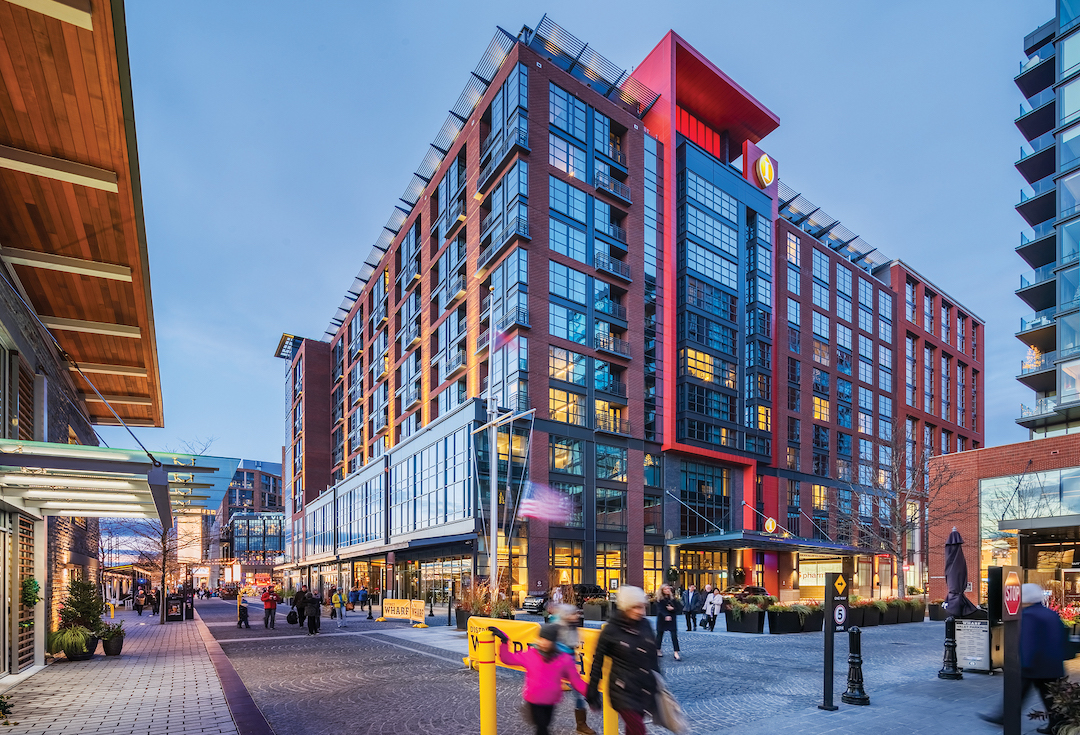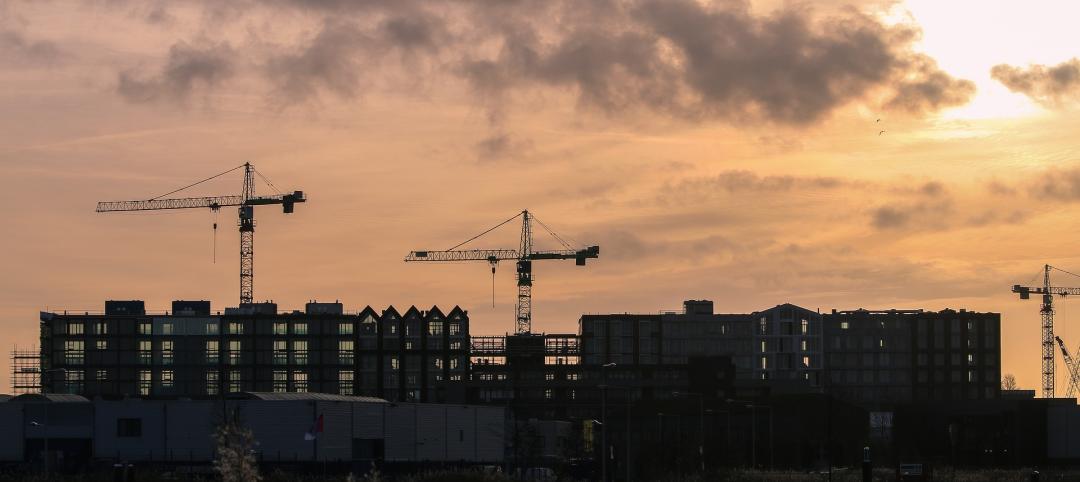Hospitality is hot—and, as we shall see, it’s also cool. Very cool.
The global hotel construction pipeline hit a 10-year high in 2018, according to Lodging Econometrics. In the U.S., nearly 670,000 rooms were in development or under construction last year—116,000 rooms shy of the 2008 peak. New York, Los Angeles, Nashville, Dallas, and Houston are particularly robust.
Upgrading the guest experience is a major focus of the sector. “Amenities are getting designed early,” says Ed Cettina, CEO, Global Building Construction, AECOM.
In some cases, the property is conceived around amenities, particularly dining and wellness spaces. A growing number of hotels and resorts have partnered with third-party restaurateurs to create multiple dining options under the same roof. “Large resorts might have seven to fifteen food and beverage venues,” says Eddie Abeyta, AIA, LEED AP, Principal, Chief Design Officer, HKS.
Lush spas are a must for new four- and five-star properties. In the casino/resort submarket, “there is a trend to capture more overnight stays by offering well-appointed spas for spouses,” says Brent Hughes, Vice President of Operations, C.W. Driver Companies.
Related content: Top 110 Hotel Architecture Firms for 2019
Related content: Top 70 Hotel Engineering Firms for 2019
Related content: Top 85 Hotel Construction Firms for 2019
Fitness and wellness are strong themes in many new developments. The recently opened Equinox Hotel at New York’s Hudson Yards boasts “the world’s most advanced fitness experiences, 24 hours a day.” Equinox owns hundreds of upscale gyms nationwide, but Hudson Yards is its first in the hospitality realm—and, at 60,000 sf, its largest.
Some properties are offering medical treatment, even surgical facilities, on site, says Ben Martin, HKS’s Principal and Director of Consulting. Hair transplants, Botox, liposuction, and nips and tucks can be had in private resort settings offering luxurious recovery rooms.
Hospitality sector turns to destination tourism
A new resort will offer guests an agritourism experience. The project, being developed by a well-known brand, addresses two strong industry trends: wellness and regional authenticity, says Melissa Voelker, AIA, NCARB, LEED AP, HKS’s Senior Vice President, Hospitality Group. Located in a pastoral setting about two hours from Philadelphia, the resort will offer rest, relaxation, spa pampering, and excursions to local farms to harvest fruits and vegetables.\
Participants will then trek to a resort restaurant for a lesson from the chef in preparing the harvest for that night’s dinner. “Tourism is changing,” Voelcker says. “Travelers are looking for destinations where they can touch the community and the lifestyle.”
Tourists are also demanding venues in far-flung outposts, even in the Arctic Circle and Antarctica. “Cold is the new hot,” says Martin. Norway’s Svart Hotel is billed as “the world’s first energy-positive hotel concept by the Arctic Circle.” Set to open in 2021, the generously fenestrated donut-shaped structure will offer panoramic views of a glacier, arctic landscape, and the Northern Lights. At the other end of the earth, the White Desert Resort in Antarctica serves those who want “a carbon-neutral experience that is as luxurious as it is adventurous.” Travelers can check out the local Emperor penguins.
At a more mundane level, hotels are delivering a home away from home experience with large-screen TVs and digital entertainment options, says Hughes. Guests want to binge watch their favorite Netflix shows and view YouTube clips on the road, just like at home. “Wi-Fi is incredibly important,” Hughes says. “Bad Wi-Fi will definitely get mentioned on Yelp.”
Technology is also having a big impact behind the scenes, particularly on project programming and preliminary design. Leo A Daly designers use tools powered by artificial intelligence to compare thousands of possible building forms and parameters—site topography, zoning requirements, the structure’s footprint, orientation, guest room sizes, and corridor widths. AI tools can crunch hundreds of thousands of factors, taking into account the clients’ financial models and looking at the ramifications of different design parameters, and produce a dozen basic building models. From there, designers can evaluate the options for presentation to the clients.
The technology reduces the time needed to develop the basic outline of a design, leaving more time to explore the finer aspects, says Ryan D. Martin, AIA, NCARB, Vice President, Director of Hospitality Architecture, Leo A Daly. AI-driven tools are good at repetitious, rule-of-thumb processes. “We’re trying to let AI do that, so we can spend more time on the fun stuff,” he says.
AI-aided models can incorporate empirical business data, such as projected revenue per room, to guide designers’ decisions on the guest experience, functional flow, and spatial adjacencies within the financial context of the project. “AI lends credibility to the decisions we make,” says Martin.
AI tools are not right for every project, says Martin. “Some are too small; some do not have enough variation in them. But they are increasingly a part of our process.”
HOTEL SECTOR TAKING IN MODULAR
Hospitality project innovation is extending to construction techniques. Marriott International said in April that it will build the world’s tallest modular hotel in New York City. The $65 million, 360-foot-tall AC Hotel New York NoMad is scheduled for final on-site assembly in late fall, with a late 2020 planned opening. The property’s 168 prefabricated fully furnished guest rooms will be stacked on top of a traditionally built podium.
Since 2017, Marriott’s development partners in North America have opened 31 low-rise structures that incorporate prefabricated guestrooms or bathrooms. The hospitality giants’ goals for modular include reducing construction costs for its franchisees, speeding up scheduling, and coping with the U.S. construction labor shortage.
Innovation in programming, design, and construction is making the hospitality segment a highly engaging market for AEC firms.
MORE FROM BD+C'S 2019 GIANTS 300 REPORT
Related Stories
Giants 400 | Feb 3, 2023
Top Workplace/Interior Fitout Architecture, Engineering, and Construction Firms for 2022
Gensler, Interior Architects, AECOM, STO Building Group, and CBRE top the ranking of the nation's largest workplace/interior fitout architecture, engineering, and construction firms, as reported in Building Design+Construction's 2022 Giants 400 Report.
Giants 400 | Feb 2, 2023
Top 20 Integrated Project Delivery (IPD) Construction Firms for 2022
Barton Malow, Gilbane, DPR Construction, and STO Building Group top the rankings of the nation's largest integrated project delivery (IPD) construction firms for buildings construction work, according to BD+C's 2022 Giants 400 Report.
Giants 400 | Feb 2, 2023
Top 100 Design-Build Construction Firms for 2022
ARCO Construction, Hensel Phelps, Ryan Companies, and Swinerton top the rankings of the nation's largest design-build construction firms for buildings construction work, according to BD+C's 2022 Giants 400 Report.
Giants 400 | Feb 2, 2023
2022 Convention Center Sector Giants: Top architecture, engineering, and construction firms in the U.S. convention and conference facilities sector
Clark Group, EUA, KPFF, Populous, TVS, and Walter P Moore top BD+C's rankings of the nation's largest convention and conference facilities architecture, engineering, and construction firms, as reported in the 2022 Giants 400 Report.
Giants 400 | Feb 1, 2023
2022 Cultural Facilities Giants: Top architecture, engineering, and construction firms in the U.S. cultural facilities sector
Populous, DLR Group, KPFF, Arup, and Turner Construction head BD+C's rankings of the nation's largest cultural facilities sector architecture, engineering, and construction firms, as reported in the 2022 Giants 400 Report. Building types include museums, public libraries, performing arts centers, and concert venues.
Giants 400 | Jan 31, 2023
2022 Retail Giants: Top architecture, engineering, and construction firms in the U.S. retail building sector
Gensler, CallisonRTKL, Kimley-Horn, Henderson Engineers, Whiting-Turner Contracting, and Turner Construction top BD+C's rankings of the nation's largest retail sector architecture, engineering, and construction firms, as reported in the 2022 Giants 400 Report.
Giants 400 | Jan 31, 2023
2022 Government Sector Giants: Top architecture, engineering, and construction firms in the U.S. government buildings sector
Gensler, Jacobs, Hensel Phelps, and Page top BD+C's rankings of the nation's largest government sector architecture, engineering, and construction firms, as reported in the 2022 Giants 400 Report.
Giants 400 | Dec 1, 2022
Top 100 Office Building Core+Shell Contractors and CM Firms for 2022
Turner Construction, AECOM, Clayco, and Gilbane top the ranking of the nation's largest office building core+shell contractors and construction management (CM) firms for 2022, as reported in Building Design+Construction's 2022 Giants 400 Report.
Giants 400 | Dec 1, 2022
Top 75 Office Building Core+Shell Engineering + EA Firms for 2022
Jacobs, Alfa Tech, Burns & McDonnell, and Arup head the ranking of the nation's largest office building core+shell engineering and engineering/architecture (EA) firms for 2022, as reported in Building Design+Construction's 2022 Giants 400 Report.
Giants 400 | Dec 1, 2022
Top 150 Office Building Core+Shell Architecture + AE Firms for 2022
Gensler, NBBJ, Perkins and Will, and Stantec top the ranking of the nation's largest office building core+shell architecture and architecture/engineering (AE) firms for 2022, as reported in Building Design+Construction's 2022 Giants 400 Report.

















